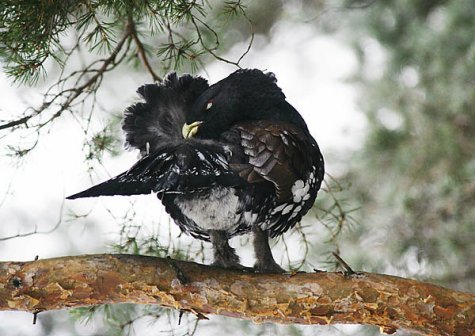The winter of landfowl
Photo: Arne Ader
Translation: Liis
Capercaillie cock
| Capercaillie |
Metsis e mõtus
|
Tetrao urogallus |
It would seem that the forests that groan under their load of snow are empty of birds, but life in the woods hasn’t stopped.
In bogs, bog pine forests and neighbouring areas you can meet a long-time native of Estonian nature – the capercaillie. It is our largest Galliformes or landfowl species. The powerful, sturdy cock may weigh up to 4 kilos when fully grown; the hens weigh only half as much and differ, apart from the size, also in colour – a phenomenon called dimorphism, common among the Galliformes birds.
The basic winter food is pine needles with little nutritional value. At least about 200 grams of needles must be eaten per day. To “mill“ the hard and sharp needles in the crop the capercaillie needs pebbles so when gravelled smaller roads have been ploughed open from snow the birds can be seen pecking around there.
A magnificent sight – a goose-sized wild bird, not in any camouflage colours, up in a tree. The feet of the capercaillie are covered with fur-like feathers that are denser in winter and at the sides of the toes there are horny outgrowths that help to keep a grip on slippery pine branches and to move on thick snow as if with show-shoes.
Their number is estimated at between 3000 to 5500 birds
Just a note: in winter grouse feed on buds in birch forests but if you come across a large landfowl in a bog pine area it is very likely a capercaillie.









